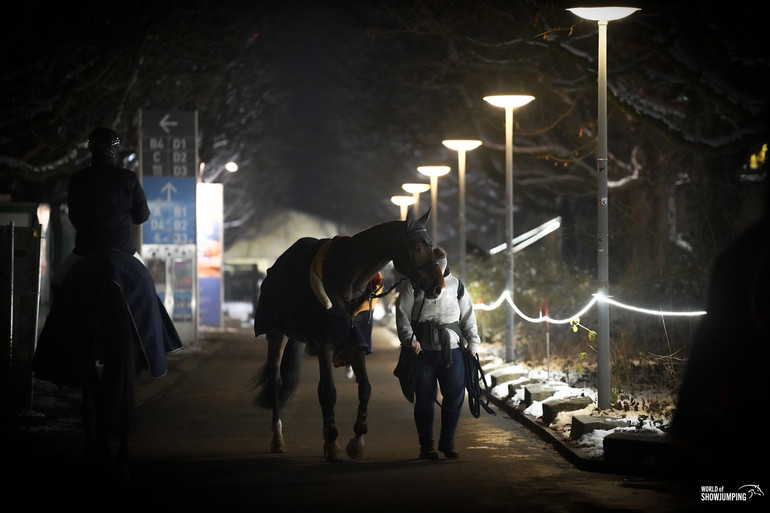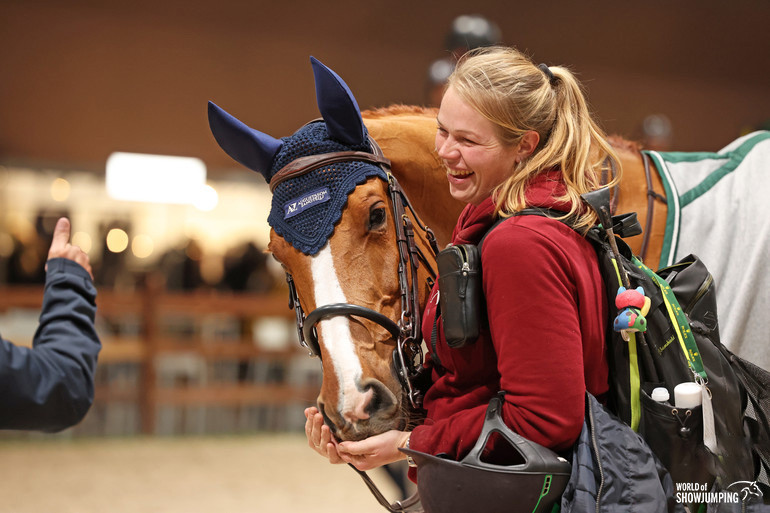Text © World of Showjumping
Last year’s changes to the FEI Veterinary Regulations – that came into effect January 1, 2023 – included a rule addition on the mandatory closure of the FEI stables area for six consecutive hours overnight, ref. article 1008, with minimal lighting and noise to allow the horses to rest adequately.
However, in reality, there have been few changes in the timetables at FEI events since. As an example, the last CSI5* class of each day started at 9PM at this year's edition of Gothenburg Horse Show, while in Amsterdam the last CSI5* jumping classes started at 9.15PM on each day, and in Leipzig there were national jumping classes and driving competitions starting as late as 10.30PM as well as a six-bar competition that started after 11PM.
The only option is more realistic timetables
“Everyone speaks about horse welfare, but in reality, little is done,” Andrea Hoenack – who for the past 12 years has worked alongside Brazil’s Marlon Modolo Zanotelli as his show groom – tells WoSJ. “The current regulations also do not help – we should use more common sense instead.”
Everyone speaks about horse welfare, but in reality, little is done
- Andrea Hoenack, show groom -
“Additionally, the organisers have to understand the reality of the grooms’ work: It continues for approximately two hours after a class is finished,” Hoenack explains about the effect of the timetables set up by organising committees, which are approved by the FEI. “Furthermore, our horses need to get fed at the same time each morning – which usually is around 7AM at the latest. Therefore, justifying late-night classes with the fact that there aren’t any five-star classes early the next morning just does not make any sense.”
“It should be the responsibility of the organisers to respect our work and create schedules that are sustainable and actually consider horse welfare. Enforcing this rule and closing the stables while we are not done with our work is also not acceptable. Therefore, the only option is to have more realistic timetables,” Hoenack points out.
Supporting equine welfare but without particular feedback
“The inclusion was made to support equine welfare in providing a suitable environment in which they can rest and sleep adequately without disturbances,” a FEI spokesperson explained to WoSJ when asked how the FEI proactively enforces the rule in question when approving schedules for FEI events – where the starting times for each competition are included. “Horses that are unable to sleep adequately can experience sleep deprivation, in a similar way to humans.”
It is the OC’s responsibility to implement this Rule and the Veterinary Delegate to report if the rule has not been observed as this is a Veterinary matter
- FEI on art. 1008 I 6 j) -
“It is the OC’s responsibility to implement this Rule and the Veterinary Delegate to report if the rule has not been observed as this is a Veterinary matter,” the spokesperson continued. “For Officials, should they want to report any veterinary concerns, the first port of call should be with the Veterinary Delegate.”
We have not had any particular feedback from our Stakeholders since it was implemented or during the Rules Revision process
- FEI on art. 1008 I 6 j) -
“Generally the rule change has been well perceived as it is entirely in the interest of the horses getting adequate rest whilst at FEI shows,” the spokesperson said when asked how this particular rule change has been received. “That being said, we have not had any particular feedback from our Stakeholders since it was implemented or during the Rules Revision process. We can’t disclose if issues have been reported as this is confidential between the OC and the FEI, however, should there be any specific concerns in relation to FEI Veterinary Regulations Article 1008.6.j, this would be reported to the FEI by the Veterinary Delegate, and the FEI would then follow this up with the relevant OC, as is customary when there are reported violations of FEI Veterinary Regulations.”
A community approach is required
“We are encouraging our community to fully embrace the new rule educating about this essential health requirement,” the spokesperson continued. “A community approach is required to provide the most optimal environment at events to keep horses as healthy as possible. The FEI believes all members of the community have a responsibility to proactively contribute and acquaint themselves with all Rules changes, and to ensure they are correctly applied in their respective domains."
A community approach is required to provide the most optimal environment at events to keep horses as healthy as possible
- FEI on art. 1008 I 6 j) -
"There is a robust FEI Rules Revision system in place which provides ample opportunities to take part in the process, with a consultation period between the FEI, National Federations and Member Associations, as well as dedicated sessions at the FEI Sports Forum in April every year to discuss and receive feedback from the community prior to changes being submitted to the vote at the General Assembly in November. In addition, following the General Assembly, the FEI publishes dedicated videos through FEI Campus outlining approved Rule changes, and encouraging Stakeholders to familiarise themselves with any new/updated Rules through the Rules App or Hub, with both mark-up and clean versions of all FEI Rules and Regulations available thus allowing Stakeholders to see clearly which articles have been modified/added.”
Playing catch with responsibility
“Indoor shows have always been very difficult, and traditionally the classes are finished late,” Rodrigo Pessoa – FEI Athlete Representative for the jumping riders – comments to World of Showjumping on the situation. “What must be taken into consideration, is that a class finishing does not mean that the grooms are finished. They have another 1.5-2 hours of work, and also have to get up early again the next morning – so this is something the FEI has to take care of. They have to enforce the rule when approving the timetables and schedules.”
We are going to suggest a 10 hour break in between competitions for each horse and for shows not to start before 7.30AM and end before 11.30PM
- Peter Bollen, president of the Equestrian Organisers -
“In general, the opinion of the organisers is that late classes are a problem of the indoor shows and not so much of outdoor shows,” Peter Bollen, president of the Equestrian Organisers (EO), explains. “However, we have to be careful that we don't kill the sport because for the major indoor shows – like the World Cup events – the main programme is in the evening. It's a fact that the public comes for the evening sessions and not during the day. Therefore, it would be very negative for the sport if we were to say that all classes have to be finished at 9PM. However, I personally think that closing the stables for six hours does not give the horses enough time to recover. The time should be longer, in my opinion minimum eight hours. Together with the International Grooms Assocication (IGA), EO is working on a new rule proposal to make the rest time longer and more regulated. We are going to suggest a 10 hour break in between competitions for each horse and for shows not to start before 7.30AM and end before 11.30PM.”
“One more point that is forgotten is that the rider as the employer actually is responsible for the groom and for their work,” Bollen continues. “Grooms are blaming the organisers, when they should talk with their employer. For example, grooms work very hard during the shows for 3-4 days and then have to drive the truck back home. That is irresponsible. In my opinion, it is the responsibility of the rider to hire a driver so that the groom can rest. These are issues that that need to be addressed. And just a crazy thought; if there is a late class, the rider can also wake up in the morning and feed the horses once…”
We need a change of culture
“The IGA has represented its members by working on a proposal with the EO which has now been submitted to the FEI,” Lucy Katan, Executive Director of IGA, explains to WoSJ. “The initial version did not consider the grooms enough because it is assumed that if a horse was resting for 6 hours, that meant that the groom also rested for 6 hours; of course, this is never the case. At the majority of shows, the rider will have more than one horse of different competition levels, often resulting in the youngster being competed in the early morning class and the more experienced horses in the late evening class. The new proposal takes this into account.”
“Working time regulations vary throughout the world, however, it is commonplace for legislation to require that an individual must rest for 11 hours between shifts,” Katan points out. “Where this is not possible due to work commitments, the employee is permitted to take a rest at another point in the day – for example a 2–3-hour rest in the middle of the day.”
It benefits very few for a class to begin so late in the evening, especially the horses
- Lucy Katan, Executive Director of IGA -
“The IGA agrees that the very late competition end times should be amended as per the programme setting of a show, and this should be within the FEI rules,” she continues. “It benefits very few for a class to begin so late in the evening, especially the horses. We all do need to be mindful that these indoor shows would not exist without the public purchasing the tickets; there does need to be an acceptance that the big class is likely to happen in the evening, however, our view is a 9 pm, at the latest, start time should be adhered to.”
“There needs to be a culture change,” Katan concludes. “Grooms need to take care of themselves to avoid burnout and riders should support this. Where there has been a late finish followed by an early start a rest period in the middle of the day should be introduced when possible. Riders need to permit and encourage their groom to take a formal break ideally away from the stable area – a genuine chance to catch up on sleep. There seems to be resistance to this happening, with an anxiety that a groom is not performing their role adequately if they depart from within the stable fence line. Why? Is there really a requirement for the groom to sit outside a stable for all this downtime? The riders do need to review their employees' working hours, particularly on the last day of the show/event. To work a 7am – 10pm day and then spend further multiple hours driving home is illegal and in breach of working time regulations plus all professional driving regulations and would probably invalidate one's insurance too. In addition, it is downright dangerous. Riders and grooms must urgently cease this practice and employ a driver to fulfil their duties.”
30.4.2024 No reproduction of any of the content in this article will be accepted without a written permission, all rights reserved © World of Showjumping.com. If copyright violations occur, a penalty fee will apply.














